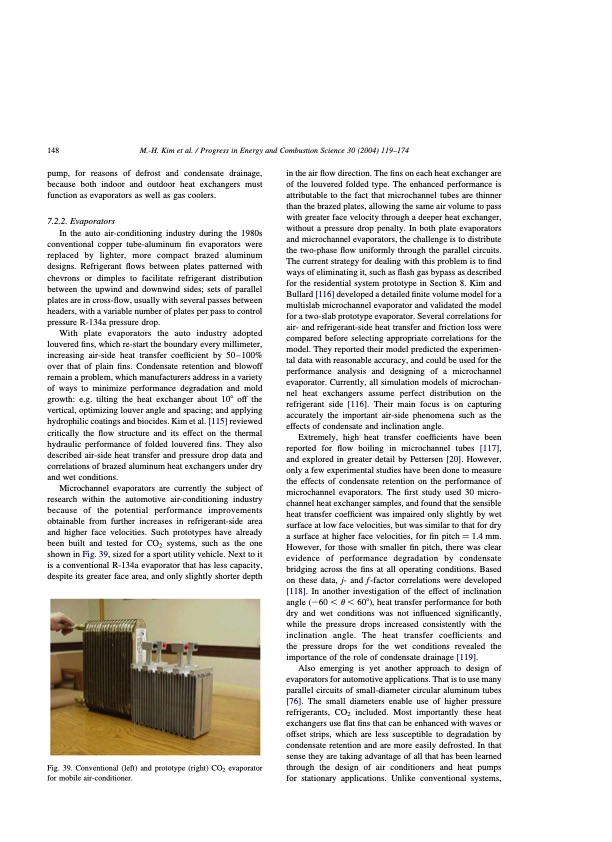
PDF Publication Title:
Text from PDF Page: 030
148 M.-H. Kim et al. / Progress in Energy and Combustion Science 30 (2004) 119–174 pump, for reasons of defrost and condensate drainage, because both indoor and outdoor heat exchangers must function as evaporators as well as gas coolers. 7.2.2. Evaporators In the auto air-conditioning industry during the 1980s conventional copper tube-aluminum fin evaporators were replaced by lighter, more compact brazed aluminum designs. Refrigerant flows between plates patterned with chevrons or dimples to facilitate refrigerant distribution between the upwind and downwind sides; sets of parallel plates are in cross-flow, usually with several passes between headers, with a variable number of plates per pass to control pressure R-134a pressure drop. With plate evaporators the auto industry adopted louvered fins, which re-start the boundary every millimeter, increasing air-side heat transfer coefficient by 50–100% over that of plain fins. Condensate retention and blowoff remain a problem, which manufacturers address in a variety of ways to minimize performance degradation and mold growth: e.g. tilting the heat exchanger about 108 off the vertical, optimizing louver angle and spacing; and applying hydrophilic coatings and biocides. Kim et al. [115] reviewed critically the flow structure and its effect on the thermal hydraulic performance of folded louvered fins. They also described air-side heat transfer and pressure drop data and correlations of brazed aluminum heat exchangers under dry and wet conditions. Microchannel evaporators are currently the subject of research within the automotive air-conditioning industry because of the potential performance improvements obtainable from further increases in refrigerant-side area and higher face velocities. Such prototypes have already been built and tested for CO2 systems, such as the one shown in Fig. 39, sized for a sport utility vehicle. Next to it is a conventional R-134a evaporator that has less capacity, despite its greater face area, and only slightly shorter depth Fig. 39. Conventional (left) and prototype (right) CO2 evaporator for mobile air-conditioner. in the air flow direction. The fins on each heat exchanger are of the louvered folded type. The enhanced performance is attributable to the fact that microchannel tubes are thinner than the brazed plates, allowing the same air volume to pass with greater face velocity through a deeper heat exchanger, without a pressure drop penalty. In both plate evaporators and microchannel evaporators, the challenge is to distribute the two-phase flow uniformly through the parallel circuits. The current strategy for dealing with this problem is to find ways of eliminating it, such as flash gas bypass as described for the residential system prototype in Section 8. Kim and Bullard [116] developed a detailed finite volume model for a multislab microchannel evaporator and validated the model for a two-slab prototype evaporator. Several correlations for air- and refrigerant-side heat transfer and friction loss were compared before selecting appropriate correlations for the model. They reported their model predicted the experimen- tal data with reasonable accuracy, and could be used for the performance analysis and designing of a microchannel evaporator. Currently, all simulation models of microchan- nel heat exchangers assume perfect distribution on the refrigerant side [116]. Their main focus is on capturing accurately the important air-side phenomena such as the effects of condensate and inclination angle. Extremely, high heat transfer coefficients have been reported for flow boiling in microchannel tubes [117], and explored in greater detail by Pettersen [20]. However, only a few experimental studies have been done to measure the effects of condensate retention on the performance of microchannel evaporators. The first study used 30 micro- channel heat exchanger samples, and found that the sensible heat transfer coefficient was impaired only slightly by wet surface at low face velocities, but was similar to that for dry a surface at higher face velocities, for fin pitch 1⁄4 1:4 mm: However, for those with smaller fin pitch, there was clear evidence of performance degradation by condensate bridging across the fins at all operating conditions. Based on these data, j- and f-factor correlations were developed [118]. In another investigation of the effect of inclination angle ð260 , u , 608Þ; heat transfer performance for both dry and wet conditions was not influenced significantly, while the pressure drops increased consistently with the inclination angle. The heat transfer coefficients and the pressure drops for the wet conditions revealed the importance of the role of condensate drainage [119]. Also emerging is yet another approach to design of evaporators for automotive applications. That is to use many parallel circuits of small-diameter circular aluminum tubes [76]. The small diameters enable use of higher pressure refrigerants, CO2 included. Most importantly these heat exchangers use flat fins that can be enhanced with waves or offset strips, which are less susceptible to degradation by condensate retention and are more easily defrosted. In that sense they are taking advantage of all that has been learned through the design of air conditioners and heat pumps for stationary applications. Unlike conventional systems,PDF Image | CO2 Vapor Compression Systems

PDF Search Title:
CO2 Vapor Compression SystemsOriginal File Name Searched:
co2-vapor-compression-systems.pdfDIY PDF Search: Google It | Yahoo | Bing
CO2 Organic Rankine Cycle Experimenter Platform The supercritical CO2 phase change system is both a heat pump and organic rankine cycle which can be used for those purposes and as a supercritical extractor for advanced subcritical and supercritical extraction technology. Uses include producing nanoparticles, precious metal CO2 extraction, lithium battery recycling, and other applications... More Info
Heat Pumps CO2 ORC Heat Pump System Platform More Info
| CONTACT TEL: 608-238-6001 Email: greg@infinityturbine.com | RSS | AMP |